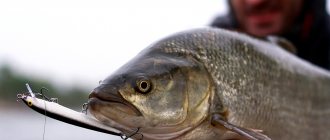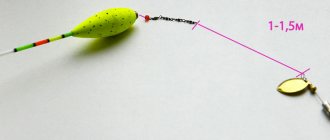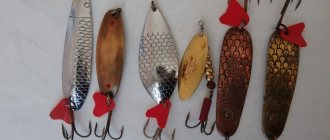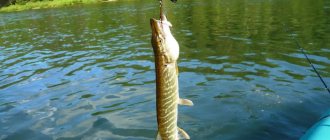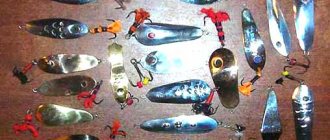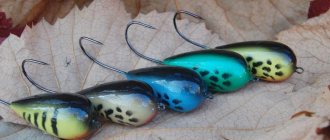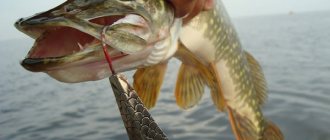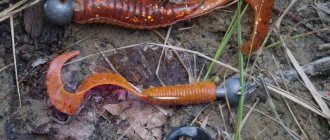Characteristics of the Kastmaster spinner
This artificial bait is considered one of the best when it comes to catching predatory fish. It attracts predatory fish, both on direct high-speed wiring and in conditions of stepped jig wiring. It is used both when fishing from the shore and when fishing from a boat.
It has good flight characteristics, a wear-resistant spoon made of metal and galvanized.
Available in five weight categories: 7.14, 21, 28 and 35 grams. The bait consists of a specially shaped body, in front of which a winding ring is fixed, and in the back there is a treble hook (tee). Rods are selected depending on the test of the bait, or the bait is bought for the test of the rod. When fishing from the shore, the optimal length of the spinning rod can be about 2.7 meters, and when fishing from a boat, a rod with a length of 1.8 meters is sufficient.
Selecting line and reel
As a rule, spinning anglers mainly use spinning reels. They are very practical and capable of providing long casts, thanks to such bait as the Kastmaster. For a fishing rod with a length of 2.7 meters, a “two-thousandth” reel is sufficient, and for a spinning rod longer than 2.7 meters, you will have to take a “three-thousandth” reel. In the first case, a fishing line with a thickness of 0.2 mm is sufficient, and for the other case, preference should be given to a fishing line with a thickness of 0.25 mm.
For greater visibility of the fishing line, it is better to give preference to fishing line in brighter colors. It is better to wind at least 100 meters of fishing line on the spool. It is better to choose a fishing line of high quality and soft, without “memory”. This approach will allow you to throw the Kastmaster as far as possible.
How to distinguish an original from a fake
Winding rings. On real products, the winding rings have an angular cut inward, but on a fake it is simply a right angle;
- Tees. The original spinners have a matte coating, because it protects them well from salt water. The hooks have a sharp end;
- Package. It is worth taking a closer look, as on fakes you can notice mistakes in the name, and the packaging itself may be wrinkled or askew;
- Dimensions. Small bait models (less than 7 grams) can only be in their original form. This is due to difficulties in manufacturing;
- Appearance. The American original has a perfect polish and is plated with high quality.
How to make a castmaster with your own hands?
The shape of this bait is not complicated, although it is made with high precision, which ensures appropriate play. Therefore, it makes sense to try making a similar bait at home.
Manufacturing methods
There are three options for making Kastmater at home:
- Based on metal wire.
- Using a plaster mold.
- Using hot casting in a special mold.
CATCHABLE SPOON FOR Pike-perch WITH YOUR OWN HANDS!
First way
To make bait using the first method, you need thick wire with a diameter of 12 to 24 mm. Rods made of stainless steel, copper or brass are suitable.
The metal rod is clamped in a vice, after which a piece is cut from it at an angle of 17 degrees. This segment is discarded. A segment is again cut from the remaining piece at the same angle. This piece of metal will serve as a blank for the future spinner. After this, all that remains is to cultivate it well, making all the cuts smoother. Then, one hole should be drilled in the spoon in the front and back for the winding rings. Finally, it is better to coat the bait with waterproof paint. The result is a rather attractive spinner, such as the “Kastmaster” from Acme.
Second way
Making bait using the second method involves slightly different steps.
On the one hand, manufacturing is very simple, but it will help you get a bait shape that is close to the original. To do this, you should take the original “Kastmaster” and a small container into which you need to pour liquid gypsum. After this, the bait is taken and pressed halfway into the plaster. At this stage, measures should be taken to ensure that the next layer of plaster does not stick to the previous one. Another layer of gypsum is poured on top. After the plaster has hardened, the upper part of the plaster mold is removed and the spoon is pulled out. After this, the two halves of the mold are again connected together and two holes are made: one for filling, and the other for air outlet.
Third way
Making a spinner using the third method also involves casting.
To do this, take a metal pipe with a diameter of about 15 mm and cut a blank from it, similar in shape to the shape of the spoon. After this, the pipe is cut lengthwise, after which the workpiece, the cut part, is attached to a metal plate. It is important that the plate fits tightly to the pipe half. All that remains is to fill it with lead or solder. After pouring and cooling, appropriate holes are made in the bait, and the spoon itself is carefully processed and polished. Finally, it is coated with waterproof paint.
Fish to catch and game features
Any predatory fish will bite well on a spoon of this type if played correctly. This is due to the fact that when moving in the water column, Kastmaster outwardly imitates the movements of fry, and not a single predator will pass by such easy prey. These spoons are most often used for fishing:
- asp,
- pike perch,
- perch,
- pike,
- chub.
The only difference here is what weight of spinner to use and the methods of play.
Such a spinner is characterized by strong play in all bodies of water, even with weak currents or its complete absence. Despite its considerable weight, this tackle will always return to the shore without any problems, especially when using fast retrieval. Because of this feature, its use becomes possible both when fishing in shallow reservoirs and in deep ones. Despite the high activity of the Castmaster's game, much depends on the experience and skills of the fisherman. The most successful fishing will be with a fisherman who knows the preferences of a particular type of fish. It is worth noting that such a spinner strongly attracts predators, both with slow and fast retrieves.
Wiring technique
Falls
Kastmaster (Kastmaster) is a universal spoon for pike, pike perch, perch, chub, asp. On the river!
The first stage of the fall of the spinner determines the beginning of the retrieve. After the spoon freely sinks to a certain depth, and this is mainly the bottom of the reservoir, you should make 2-3 turns with the reel to raise the spoon to a height of 2 meters from the bottom. If you need to lift it into the middle layers of water, you will have to make about 5-7 revolutions. If you turn the reel up to 20 times, the spoon will rise closer to the surface of the water.
After rising to the desired height, the bait is again given the opportunity to fall closer to the bottom.
Bites can occur both during the rise of the spoon and during free fall. The bite is transmitted to the tip of the rod. During the biting process, the line may be stretched. At the same time, we should not forget that hooks are also possible, therefore, the hooking process does not need to be forced. This fishing technique is suitable for reservoirs whose depth does not exceed 2 meters.
Climb
Lifts are part of the classic “American” retrieve, when the lure is cast, and after it reaches the bottom, the lift is carried out by lifting the rod at an angle of up to 60 degrees. At the top point of the lift, you should pause, and then the rod lowers to the starting point. This should be followed again by a pause and rewinding, after which the movements are again repeated in the same order.
As a rule, in such cases, bites follow during pauses. The bite can be felt with your hand, and can also be determined by the characteristic bend of the rod tip.
This type of wiring is suitable for reservoirs whose depth is at least 1 meter.
Uniform wiring
This is the most accessible and easiest type of fishing, which is mastered in the first stages of spinning fishing techniques. The most important thing here is to wind the line evenly onto the reel. Uniform wiring is used on all types of reservoirs with different depths.
Combined wiring
This type of wiring is nothing more than a combination of simple wiring, such as raising/lowering and uniform winding. The only thing is that it is possible to experiment with the speed of wiring and the duration of pauses during the entire wiring process. Mastering this type of wiring should follow the mastery of simpler wiring, which appears already in the process of gaining experience. Therefore, we can safely say that combined wiring is the lot of experienced spinning players.
Ultralight. Catching perch with castmaster
Castmaster lure fishing in still water
The castmaster spoon shows its “talent” of falling to the bottom, like a wounded fish, best in still water or with a slight current. The next method of wiring is based on a vertical drop, dragging with twitching and the use of jig steps.
So, after casting, we close the line handle, take out the slack in the line and wait until the bait slowly sinks to the bottom, slightly swaying with its sides, it is this movement that most often attracts cautious predatory fish. A bite can happen at the moment when the spoon has almost reached the bottom or as soon as it falls on the ground, raising a cloudy cloud. In this phase of the wiring you need to be ready to make a hook.
If there is no bite after the bait falls to the bottom, we begin the next stage of wiring - dragging with twitching. Our task is to animate the castmaster in such a way that it resembles the attempts of a stricken fish to break away from the bottom. This can be achieved if we pull the line very slowly and, at the same time, slightly twitch the rod tip, as when playing with a jig. The spinner will “crawl”, raising a cloud of turbidity from the bottom, and slightly swaying and sparkling on its sides. This behavior of the bait can provoke an attack by pike perch, pike and other predatory fish.
The next stage of wiring is the “step”. At this stage, the castmaster spoon should move slightly floating up and falling to the bottom again. You can lift the bait from the bottom by turning the reel, as when jigging, or by tossing the tip of a spinning rod and picking up the slack in the fishing line. The castmaster must move at a minimum speed, and then the predatory fish, which did not dare to attack at the previous stages, must now rush to the “prey” that is eluding it.
Bottom jerk (American) wiring
For fishing with fast-sinking baits (oscillating spoons, front-loaded spinners, heavy rattlins), a bottom jerking retrieve called American was invented. American wiring resembles the wiring described above, but somewhat simplified. So, after casting, the spinning rod is aimed at the castmaster lying on the bottom, then a sharp jerk is made with the rod upward. The spinning rod becomes vertical, and the spinner makes a jump from the bottom to the entire length of the raised rod. The weakened line sags, and the castmaster begins, swaying, to sink to the bottom. After this, the reel picks up the slack in the line and the cycle repeats.
Castmaster lure fishing with step-by-step jig
Anglers familiar with jigging, but using a castmaster spinner for the first time, can start fishing with a classic stepped retrieve. That is, using the castmaster as a jig head, wait until the spoon falls to the bottom, then lift it by rotating the reel with the rod stationary and again release the bait into free fall. By increasing or decreasing the rotation speed of the reel, the length of the line, and the duration of pauses, you can study the behavior of the castmaster underwater in order to further improve the animation of this bait.
Fishing tactics
We are looking for the optimal wiring method
As a rule, spinning anglers begin to fish water areas, starting with the simplest retrieves and with short casts. Having fished the coastal zone, the fisherman begins to move on to long-distance fishing, including more complex types of fishing. Moreover, it is advisable not to throw the bait at the same point, but to throw it into one place no more than 5-7 times, after which you need to move to another, more promising place.
Choosing a place to catch predatory fish
The outcome of successful fishing depends on how well the fishing spot is chosen. Most of the predatory fish are found on the rifts, as well as in places where there are exits from holes. “Castmaster” must be cast at a certain angle to the current, if there is one. If there is no current, then you can cast to any point in the reservoir. When fishing in the current, it is better to use bait weighing 25 grams or more. It is possible to cast such baits at a distance of up to 100 meters.
Choosing the right bait
The choice of bait weight depends on the size of the fish that is intended to be caught and the fishing conditions. For catching perch, a spinner weighing 7 grams or 14 grams is sufficient. Asp, which is preferred by fry, are also caught with such a “Castmaster”. But for catching pike, especially trophy ones, it is better to take a spoon weighing 21 grams or more.
Spinning rod and reel for castmaster fishing
Traditionally, anglers who prefer spinning fishing opt for spinning reels.
They are very convenient for this method of fishing and are well suited for long casts, which is especially important when fishing from the shore. A heavy spoon such as Kastmaster will also help to maximize your casting distance. For a three-meter-long spinning rod, a two-thousandth reel will be quite sufficient, but a spinning rod with a longer length will have to be equipped with a three-thousandth reel.
And if in the first case a fishing line with a thickness of 0.2 millimeters is suitable, then in the second you will have to opt for a fishing line with a thickness of 0.25 millimeters.
